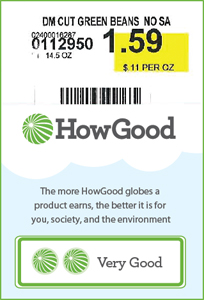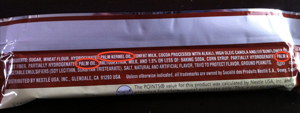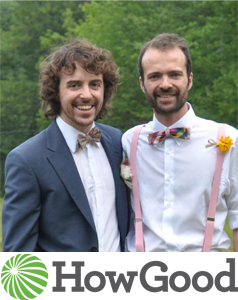I’d never given much thought to milk. It’s just milk after all. When my daughter turned one last year and started drinking it, suddenly milk wasn’t just milk. In my mind there was milk that I wouldn’t dare let her drink, and there was the best milk I could possibly give to her. I didn’t want her tiny body being exposed to unnecessary hormones, chemicals, or anything else that milk has been getting a bad rap for. I just wanted her to simply have a cup of the protein-rich food that would help her grow to be the big girl that she now thinks she is, on the cusp of a second birthday.
 Standing at the grocery cooler inspecting the dozens of options before me, in the end I had a package and price to go off of. I had to weigh the two and make my selection. However, if I were researching my milk purchase today, I might be able to consider the product’s HowGood score. Horizon would have no “globes,” Stonyfield would have a “good” score with one globe, and Organic Valley would have a “very good” score with two globes.
Standing at the grocery cooler inspecting the dozens of options before me, in the end I had a package and price to go off of. I had to weigh the two and make my selection. However, if I were researching my milk purchase today, I might be able to consider the product’s HowGood score. Horizon would have no “globes,” Stonyfield would have a “good” score with one globe, and Organic Valley would have a “very good” score with two globes.
You have no idea what I’m talking about, but Alexander Gillett is working really hard to change that. He and his brother, Arthur, launched HowGood four months ago. They’ve scored more than 100,000 products and awarded each of them zero to three globes. The more globes, the more sustainable the product is.
Alexander explained that with the HowGood sustainability rating displayed right on the price tag at the point of purchase people can expand their decision based on more than price and package claims. He says they’ve found that people are willing to pay a little more for a “greener” product. “The reality is a product that is sustainable costs a little bit more,” he told us.
This is why the “best milk” isn’t always going to be determined by a price or marketing. He explained that the “best milk” may cost even 15 cents more than its seemingly similar competitor, but customers are willing to pay that. “The best-rated milk product saw an increase in sales of 36 percent in one month, and continued over the next four months,” Alexander told us of actual stores sales where the HowGood label was used.
It’s not just packaged foods that HowGood scores. For instance, Alexander explained that “A well produced tomato in healthy soil can have up to three times the amount of nutrients than others based on exposure to fertilizers.” Wouldn’t you want to know that when you’re scanning over the romas, grapes, and vine-ripened tomatoes in your produce section?
How HowGood Works
 The HowGood scores, indicated by one, two, or three globes, are determined by looking at 60 indicators for how a product impacts the environment including best growing practices, human rights practices, community impact, ingredient profile and sourcing, management accountability, and more. They don’t specifically look at the nutrition profile of a product (i.e. its calories and fat), but unhealthy foods tend to weed themselves out of a good score because they tend to be highly processed. Simpler foods with less ingredients tend to be more digestible, and less chemicals in the food system means less chemicals in our bodies, thus the more processed a food is it generally has a lower score. “The best thing you can do is not process [the food],” he said. “Simple ingredients…have less of an impact on the environment.”
The HowGood scores, indicated by one, two, or three globes, are determined by looking at 60 indicators for how a product impacts the environment including best growing practices, human rights practices, community impact, ingredient profile and sourcing, management accountability, and more. They don’t specifically look at the nutrition profile of a product (i.e. its calories and fat), but unhealthy foods tend to weed themselves out of a good score because they tend to be highly processed. Simpler foods with less ingredients tend to be more digestible, and less chemicals in the food system means less chemicals in our bodies, thus the more processed a food is it generally has a lower score. “The best thing you can do is not process [the food],” he said. “Simple ingredients…have less of an impact on the environment.”
HowGood at the Point of Purchase
HowGood launched in late 2025 in three independent grocery stores – Green Grape in Brooklyn, Stumps Market in San Diego, and Weaver’s Way Co-Op in Philadelphia. Next up, the grocery chain HyVee is considering a test in 200 stores. While the benefit to consumers seems fairly evident, in that it helps them make better product selections, the benefit to grocers may not seem as obvious. “We’re not increasing tonnage, we’re increasing the basket size,” says Alexander of the potential for HowGood to influence grocery sales. When customers start paying “the real cost of food” their receipts ring up a little higher; but he’ll argue that the cost to our planet otherwise is far greater in the long run.
“Food is so cheap in our society because we’re cutting corners and the products aren’t sustainable. With the HowGood score, we’re seeing what food should cost,” he explained.
The HowGood label at the point-of-purchase draws a “sought-after demographic,” he explained, which is good for a grocer’s bottom line. HowGood is fighting for some of the smallest, and most valuable, real estate in the entire grocery store – the price sticker on the shelf. There isn’t much competition, but the number of specialty labels for quality of food seem to be growing. He acknowledged the NuVal rating (used in HyVee stores) is a competitor, but only in the sense that they both want that prime price-tag real estate. Despite competing for inches, Alexander believes they won’t have to. “The reality is companies like HyVee want to use both,” referring to HowGood and NuVal because each delivers valuable information to customers. And while HowGood doesn’t specifically speak to the nutritional quality of a food like NuVal does, he says “people associate sustainability with a product that is good for them.” In that, everybody wins.
Alexander and Arthur aren’t the guys scoring products. Instead, they have a research team at their Tennessee location and they reach out to experts in specific fields to help ensure they’re working with the best information possible.
“It’s key for us to build ratings that bring together the right group of people with experience in that industry,” said Alexander.
For instance, when studying palm oil, they worked with a professor at Duke University who specializes in the subject. They learned that “there isn’t really a sustainable way to source [palm oil], there are just some that are less worse.” With that understanding, an ingredient label that includes palm oil isn’t as likely to get a perfect or even “very good” score.
In a survey conducted by the HowGood team, they found that 95 percent of consumers would buy green products, 63 percent are actively looking for green products, and 22 percent are actually buying green products. “People have lost trust in marketing,” said Alexander, and his unbiased HowGood label is helping people look past the pretty pictures and catchy phrases on the front of milk cartons and hundreds of thousands of other products at the store to understand the real story behind a product.
When we buy homes, cars, electronics, and even furniture we can spend days or even weeks mulling over ratings, reviews, and industry analyses before we hand over thousands of dollars. Consumers will go out of their way to educate themselves before the purchase, and the web is a huge contributing factor for that, with ample information available. When you walk in to the car dealership or model home, you know exactly what to ask and where to stand firm on price.
Can you imagine if we paid that much care to the food we purchase weekly, and sometimes daily? As Alexander argues, having this information online is one thing, but “It can’t just be on the web, it has to be at the point of purchase.” When standing in front of far too many choices for cereals, breads, tomatoes, and milk, we need to be able to make snap decisions. If price, packaging, and even brand name aren’t selling you any more, the HowGood rating should do it.
As explained, you’ll currently only find the HowGood rating displayed in three specialty grocery stores. If you want to see it in yours, bug the heck out of your grocery store manager and give them this HowGood contact information.


